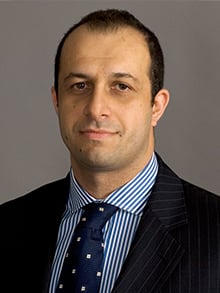
Markets are pricing in further interest rate cuts even as government spending remains high. VINCE PEZZULLO explains why this kind of ‘hopium’ is not a strategy
- Further rate cuts unlikely if government keeps spending
- Rethink high priced ASX leaders
- Find out about Perpetual Equity Investment Company (ASX:PIC)
HIGH government spending across major economies is reshaping markets, forcing investors to adapt to a world of persistently higher inflation and tighter monetary policy, says Perpetual’s head of equities, Vince Pezzullo.
The policy stance is a reversal of post-GFC austerity where governments tightened spending and interest rates fell to zero – but it’s a shift investors have yet to price in, he says.
The Australian government is lifting spending on welfare and assisting selected businesses, while the US is safeguarding domestic industry and implementing tax cuts.
“We’re in an age of fiscal dominance,” says Pezzullo.
“When governments are spending so aggressively, you’re going to run with a hotter economy.
“That means monetary policy is going to be less accommodative while governments are still spending.”
Pezzullo is co-portfolio manager of the Perpetual Equity Investment Company (ASX:PIC).
Private sector capital strike
Higher government spending boosts economic growth but comes at the cost of higher prices and lower private sector activity.
“Traditionally, when you have governments driving economic growth rather than the private sector, at some point, the private sector is going to be the buffer,” says Pezzullo.
Governments are price-insensitive and will complete projects “at any cost”, while the more disciplined private sector tends to slow spending as prices rise – leading to what Pezzullo calls a ‘capital strike’.
“You’ll have a bit of a capital strike in the private sector. And you’re starting to see that happen now,” he says.
This creates risk and opportunity for investors.
“The things we focus on are trying to tilt the portfolio to protect the downside, more importantly, and position ourselves where we think there are opportunities – where there is a bit of growth, or where the equity is significantly mispriced,” says Pezzullo.
‘Goldilocks’ expectations
Despite slowing earnings and persistent inflation, equity markets remain buoyant.
Pezzullo says investors are pricing in an unlikely combination of further rate cuts alongside continued high government stimulus.
“The market’s full of hope at the moment, because there’s an expectation of rate cuts while the government’s spending at the same time,” says Pezzullo.
“That is very much Goldilocks.
“It’s very difficult for that to happen.”
The ASX300’s 11 per cent rise over the past 12 months masks declining corporate profits.
“When you look at what’s happening with earnings in the last three months in particular, you’ve had downgrades across most of the industrial sector,” says Pezzullo.
But price earnings multiples have risen.
“The market is saying, ‘I’m willing to pay more today because we think tomorrow is going to be better’
“That’s very dangerous.”
Profitless companies and ‘hopium’
Pezzullo says there are other signs of excess in the ASX that should also serve as a warning.
Since 2000, loss making stocks in the ASX300 delivered an annualised return of negative 24 per cent.
Yet over the past six months, this cohort has surged more than 30 per cent, a performance seen only four times in the past 25 years: during the dotcom bubble, the GFC, the pandemic – and today.
“We won’t invest in those,” says Pezzullo.
“History has always suggested that profitless companies never tend to turn a profit. You need a bit of a miracle sometimes.”
Investor expectations are also disconnected from reality.
Over the past decade, just eight ASX100 companies managed to achieve 10 per cent annual earnings growth for three consecutive years – but today’s market is pricing 44 companies to do so.
Australia’s largest listed stocks illustrate the disconnect.
Commonwealth Bank and Wesfarmers trade on 29- and 37-times earnings respectively – and together represent 15 per cent of the ASX300.
Pezzullo says the world’s largest company, AI leader NVIDIA, trades on 27 times earnings but is growing earnings at 25 per cent annually and represents less than 10 per cent of the US market.
“NVIDIA is vilified for being a very expensive company – but they are delivering,” says Pezzullo.
“CBA and Wesfarmers are going to grow maybe mid-single digit if they’re lucky – and the two of them are very sensitive to the cycle.
“So, the market’s pretty much dealing with hopium as a strategy.”
Navigating the froth
Given these warning signs, investors need to rethink their portfolio positioning rather than chase momentum, says PIC co-portfolio manager Sean Roger.
The market is creating extreme dispersion between winners and losers. The largest companies are being pushed to extreme valuations while companies with any earnings uncertainty are being sold at almost any price.
“That momentum factor is creating this real gap between the winners and the losers,” says Roger.
“And as fundamental quality and value investors, that does create a bit of a tricky environment where valuations have taken a back seat.
“But it does also create some really interesting opportunities.”
Roger says investors should consider reducing exposure to the most expensive stocks in the ASX top 50, particularly those trading on high multiples with modest growth prospects.
Small cap stocks offer better value.
While they lagged large caps for years, the valuation gap remains wide even after their recent outperformance.
Resources also warrant increased attention as demand strengthens in China and on the back of global electrification and data centre construction, says Roger.
And international diversification also makes sense when the local market is expensive, with high-quality offshore cyclical companies showing more reasonable valuations.
“We quite like markets when they get this frothy,” says Pezzullo.
“Not too sure when, but there’s usually an opportunity around the corner.
“So, we’ll be patient – we’re happy to exit positions we feel are too expensive and wait for better opportunities.”
About Vince Pezzullo and Perpetual Equity Investment Company (ASX:PIC)
Vince is Perpetual’s head of equities and portfolio manager of Perpetual Equity Investment Company (ASX:PIC).
Vince has more than 20 years of experience in financial services including global experience as an analyst and portfolio manager.
Perpetual Equity Investment Company Limited (ASX:PIC) is a listed investment company which provides a simple and transparent way to invest in a diversified portfolio of high quality Australian and global listed securities.
PIC is managed to provide investors with an income stream and long-term capital growth.
Perpetual is a pioneer in Australian quality and value investing, with a heritage dating back to 1886.
We have a track record of contributing value through “active ownership” and deep research.
Find out about Perpetual Equity Investment Company (ASX:PIC)
Browse Perpetual’s Australian equities capabilities
Want to know more? Contact a Perpetual account manager


